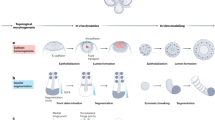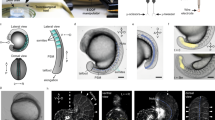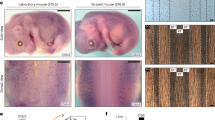Key Points
-
This article briefly discusses the role of experimental embryology (and experimental embryologists) in discovering the principles of vertebrate neural development. It provides a historical account of the roles of cutting, pasting and painting, as well as modifications of these techniques that have led to new approaches, in elucidating the principles of neural development.
-
Experimental embryologists have mainly used four vertebrate models to work out the principles of neural development: amphibians, chicks, mice and zebrafish. The strengths and weaknesses of these four vertebrate models are discussed.
-
Experimental embryology is founded on three main techniques. 'Cutting' involves either ablation — the removal and discarding of a tissue, a group of cells or single cells to test whether they are required for a particular developmental event — or the isolation of tissues and cells for further testing. 'Pasting' involves transplanting tissues or cells from donor to host embryos. 'Painting' involves the use of labelled cells for the purpose of tracking cell movements and fates during further development.
-
The central principle of vertebrate neural development is that the nervous system and associated structures, such as the nose, eyes, ears and (in some organisms) lateral line, arise through a series of inductive interactions between neighbouring cells. The use of cutting, pasting and painting by experimental embryologists has revealed several key principles of neural development that are related to the central principle.
-
The techniques of experimental embryology have contributed to the elucidation of a number of principles of vertebrate neural development. This review outlines the crucial series of experiments that led to the discovery of neural induction, and recent modifications of experimental embryological techniques that have been used to begin to work out its molecular mechanisms.
Abstract
The goal of experimental embryology seems rather simple: to manipulate embryos in systematic ways to elucidate mechanisms of development. Such manipulation involves variations in three main techniques — cutting, pasting and painting — and all three techniques have contributed enormously to the establishment of key principles of neural development.
This is a preview of subscription content, access via your institution
Access options
Subscribe to this journal
Receive 12 print issues and online access
$189.00 per year
only $15.75 per issue
Buy this article
- Purchase on Springer Link
- Instant access to full article PDF
Prices may be subject to local taxes which are calculated during checkout





Similar content being viewed by others
References
Spemann, H. & Mangold, H. Über induktion von Embryonalanlagen durch Implantation artfremder Organisatoren. Wilhelm Roux Arch. Entwicklungsmech. Organ. 100, 599–638 (1924).
Hamburger, V. A Manual of Experimental Embryology, Revised Edition (Univ. Chicago Press, Illinois, 1960).
Hamburger, V. The Heritage of Experimental Embryology. Hans Spemann and the Organizer (Oxford Univ. Press, New York, 1988).An interesting and lively historical account of the events preceding and succeeding the discovery of the organizer, as viewed by a pioneer of experimental embryology and developmental neurobiology.
Rugh, R. Experimental Embryology (Burgess, Minneapolis, 1962).
Spemann, H. Embryonic Development and Induction (Hafner, New York, 1967).A detailed account of the series of experiments carried out on amphibian embryos in Spemann's laboratory. These experiments defined the process of induction, including neural induction.
Wilt, F. H. & Wessells, N. K. Methods in Developmental Biology (Thomas Y. Crowell Co., New York, 1967).
Sive, H. L., Grainger, R. M. & Harland, R. M. Early Development of Xenopus laevis (Cold Spring Harbor Laboratory Press, New York, 2000).
Amaya, E. & Kroll, K. L. A method for generating transgenic frog embryos. Methods Mol. Biol. 97, 393–414 (1999).
New, D. A. T. A new technique for the cultivation of the chick embryo in vitro. J. Embryol. Exp. Morphol. 3, 326–331 (1955).
Auerbach, R., Kubai, L., Knighton, D. & Folkman, J. A simple procedure for the long-term cultivation of chicken embryos. Dev. Biol. 41, 391–394 (1974).
Chapman, S. C., Collignon, J., Schoenwolf, G. C. & Lumsden, A. Improved method for chick whole-embryo culture using a filter paper carrier. Dev. Dyn. 220, 284–289 (2001).
Bronner-Fraser, M. (ed.) Methods in Avian Embryology (Academic, San Diego, 1996).
Hatada, Y. & Stern, C. D. A fate map of the epiblast of the early chick embryo. Development 120, 2879–2889 (1994).
Darnell, D. K., Garcia-Martinez, V., Lopez-Sanchez, C., Yuan, S. & Schoenwolf, G. C. in Developmental Biology Protocols Vol. I (eds Tuan, R. S. & Lo, C. W.) 305–321 (Humana, Totowa, New Jersey, 2000).
Garcia-Martinez, V., Alvarez, I. S. & Schoenwolf, G. C. Locations of the ectodermal and non-ectodermal subdivisions of the epiblast at stages 3 and 4 of avian gastrulation and neurulation. J. Exp. Zool. 267, 431–446 (1993).
Lopez-Sanchez, C., Garcia-Martinez, V. & Schoenwolf, G.C. Localization of cells of the prospective neural plate, heart and somites within the primitive streak and epiblast of avian embryos at intermediate primitive-streak stages. Cells Tissues Organs 169, 334–346 (2001).
Le Douarin, N. M. & Kalcheim, C. The Neural Crest (Cambridge Univ. Press, Cambridge, 1999).
Morgan, B. A. & Fekete, D. M. in Methods in Avian Embryology (ed. Bronner-Fraser, M.) 185–218 (Academic, San Diego, 1996).
Swartz, M., Eberhart, J., Mastick, G. S. & Krull, C. E. Sparking new frontiers: using in vivo electroporation for genetic manipulations. Dev. Biol. 233, 13–21 (2001).
Timmer, J., Johnson, J. & Niswander, L. The use of in ovo electroporation for the rapid analysis of neural-specific murine enhancers. Genesis 29, 123–140 (2001).
Cockroft, D. L. in Postimplantation Mammalian Embryos: a Practical Approach (eds Copp, A. J. & Cockroft D. L.) 15–40 (IRL Press, Oxford, UK, 1990).
Hogan, B., Beddington, R., Costantini, F. & Lacy, L. Manipulating the Mouse Embryo: a Laboratory Manual (Cold Spring Harbor Laboratory Press, New York, 1994).
Wassarman, P. M. & DePamphilis, M. L. Guide to Techniques in Mouse Development (Academic, New York, 1993).
Trainor, P. A. & Tam, P. P. L. Cranial paraxial mesoderm and neural crest cells of the mouse embryo: co-distribution in the craniofacial mesenchyme but distinct segregation in branchial arches. Development 121, 2569–2582 (1995).
Lawson, K. A. & Pedersen, R. A. in Postimplantation Development in the Mouse (eds Chadwick, D. J. & Marsh, J.) 3–26 (John Wiley & Sons, Chichester, UK, 1992).
Tam, P. P. L. & Quinlan, G. A. Mapping vertebrate embryos. Curr. Biol. 6, 104–106 (1996).
Ho, R. K. & Kimmel, C. B. Commitment of cell fate in the early zebrafish embryo. Science 261, 109–111 (1993).
Kimmel, C. B. & Warga, R. M. Indeterminate cell lineage of the zebrafish embryo. Dev. Biol. 124, 269–280 (1987).
Wilson, E. T., Helde, K. A. & Grunwald, D. J. Something's fishy here — rethinking cell movements and cell fate in the zebrafish embryo. Trends Genet. 9, 348–352 (1993).
Helde, K. A., Wilson, E. T., Cretekos, C. J. & Grunwald, D. J. Contribution of early cells to the fate map of the zebrafish gastrula. Science 265, 517–520 (1994).
Behringer, R. & Magnuson, T. (eds) Morpholino gene knockdowns. Genesis 30, 89–200 (2001).
Jacobson, A. Inductive processes in embryonic development. Science 152, 25–34 (1966).A cogent and thoughtful summary of the hierarchy of tissue interactions that lead to induction, based on experiments in amphibians.
Nieuwkoop, P. & Faber, J. Normal Table of Xenopus laevis 2nd edn (North-Holland, Amsterdam, 1967).
Hamburger, V. & Hamilton, H. L. A series of normal stages in the development of the chick embryo. J. Morphol. 88, 49–92 (1951).
Eyal-Giladi, H. & Kochav, S. From cleavage to primitive streak formation: a complementary normal table and a new look at the first stages of the development of the chick. I. General morphology. Dev. Biol. 49, 321–337 (1976).
Theiler, K. The House Mouse. Development and Normal Stages from Fertilization to 4 Weeks of Age (Springer, New York, 1972).
Downs, K. M. & Davies, T. Staging of gastrulating mouse embryos by morphological landmarks in the dissecting microscope. Development 118, 1255–1266 (1993).
Hausen, P. & Riebesell, M. The Early Development of Xenopus laevis. An Atlas of the Histology (Springer, Berlin, 1991).
Patten, B. M. Early Embryology of the Chick 5th edn (McGraw-Hill, New York, 1971).
Bellairs, R. & Osmond, M. The Atlas of Chick Development (Academic, San Diego, 1998).
Rugh, R. The Mouse, its Reproduction and Development (Burgess, Minneapolis, 1968).
Kaufman, M. H. The Atlas of Mouse Development (Academic, New York, 1992).
Mathews, W. W. & Schoenwolf, G. C. Atlas of Descriptive Embryology 5th edn (Prentice Hall, New Jersey, 1998).
Schoenwolf, G. C. Laboratory Studies of Vertebrate and Invertebrate Embryos. Guide and Atlas of Descriptive and Experimental Development 8th edn (Prentice Hall, New Jersey, 2001).
Nakamura, O. & Toivonen, S. Organizer — a Milestone of a Half-Century from Spemann (Elsevier/North-Holland, Amsterdam, 1978).
Gould, S. E. & Grainger, R. M. Neural induction and antero-posterior patterning in the amphibian embryo: past, present and future. Cell. Mol. Life Sci. 53, 319–338 (1997).A scholarly update of progress in understanding tissue interactions that underlie neural induction, 30 years after Jacobson's seminal review (reference 32).
Nieuwkoop, P. D. Short historical survey of pattern formation in the endo-mesoderm and the neural anlage in the vertebrates: the role of vertical and planar inductive actions. Cell. Mol. Life Sci. 53, 305–318 (1997).
Keller, R. Gastrulation: Movements, Patterns, and Molecules (Plenum, New York, 1991).
Schoenwolf, G. C. & Smith, J. L. Mechanisms of neurulation: traditional viewpoint and recent advances. Development 109, 243–270 (1990).
Colas, J.-F. & Schoenwolf, G. C. Towards a cellular and molecular understanding of neurulation. Dev. Dyn. 221, 117–145 (2001).
Grainger, R. M. Embryonic lens induction: shedding light on vertebrate tissue determination. Trends Genet. 8, 349–355 (1992).
Ladher, R. K., Anakwe, K. U., Gurney, A. L., Schoenwolf, G. C. & Francis-West, P. H. Identification of synergistic signals initiating inner ear development. Science 290, 1965–1967 (2000).A series of experiments defining the tissue interactions that underlie induction of the inner ear in chick, and the demonstration that two growth factors/signalling molecules, FGF19 and WNT8C, act synergistically to mediate the tissue interactions.
Yamada, T., Placzek, M., Tanaka, H., Dodd, J. & Jessell, T. M. Control of cell pattern in the developing nervous system: polarizing activity of the floor plate and notochord. Cell 64, 635–647 (1991).
Lumsden, A. & Krumlauf, R. Patterning the vertebrate neuraxis. Science 274, 1109–1123 (1996).
Moury, J. D. & Jacobson, A. G. Neural fold formation at newly created boundaries between neural plate and epidermis in the axolotl. Dev. Biol. 133, 44–57 (1989).
Selleck, M. A. & Bronner-Fraser, M. The genesis of avian neural crest cells: a classic embryonic induction. Proc. Natl Acad. Sci. USA 93, 9352–9357 (1996).
Roelink, H., Tanabe, Y. & Jessell, T. M. Sonic hedgehog: a mediator of inductive signaling in the ventral neural tube. Cell Dev. Biol. 7, 121–127 (1996).
Crossley, P. H., Martinez, S. & Martin, G. R. Midbrain development induced by fgf8 in the chick embryo. Nature 380, 66–68 (1996).
Beddington, R. S. P. & Robertson, E. J. Anterior patterning in mouse. Trends Genet. 14, 277–284 (1998).A summary of evidence for the existence of a head organizer in mice, which is unique and spatially separated from the trunk–tail/Spemann organizer (that is, the node).
Smith, J. C. & Slack, J. M. Dorsalization and neural induction: properties of the organizer in Xenopus laevis. J. Embryol. Exp. Morphol. 78, 299–317 (1983).
Hemmati-Brivanlou, A. & Melton, D. Vertebrate embryonic cells will become nerve cells unless told otherwise. Cell 88, 13–17 (1997).A turning point in our understanding of neural induction. This paper presents evidence that neural is the default state of ectodermal cells.
De Robertis, E. M., Larrain, J., Oelgeschlager, M. & Wessely, O. The establishment of the Spemann's organizer and patterning of the vertebrate embryo. Nature Rev. Genet. 1, 171–181 (2000).
Sasai, Y., Lu, B., Steinbeisser, H., Geissert, D., Gont, L. K. & De Robertis, E. M. Xenopus chordin: a novel dorsalizing factor activated by organizer-specific homoeobox genes. Cell 79, 779–790 (1994).
De Robertis, E. M. & Sasai, Y. A common plan for dorsoventral patterning in Bilateria. Nature 380, 37–40 (1996).
Gerhart, J. Inversion of the chordate body axis: are there alternatives? Proc. Natl Acad. Sci. USA 97, 4445–4448 (2000).
Wolpert, L., Beddington, R., Brockes, J., Jessell, T., Lawrence, P. & Meyerowitz, E. Principles of Development (Current Biology Ltd, London, 1998).
Rasmussen, J. T., Deardorff, M. A., Tan, C., Rao, M. S., Klein, P. S. & Vetter, M. L. Regulation of eye development by frizzled signaling in Xenopus. Proc. Natl Acad. Sci. USA 98, 3861–3866 (2001).This paper presents the extraordinary finding that a single transmembrane receptor (frizzled 3) for a signalling molecule, when overexpressed, results in the formation of a complex structure (the eye), and that expression of a dominant-negative form of this receptor on one side of the embryo completely blocks eye formation on that side.
Acknowledgements
Research on this subject in my laboratory was supported by the US National Institutes of Health. This article is dedicated to the memory of Viktor Hamburger, a pioneer in experimental embryology and neural development, and one of my scientific heroes. I am indebted to the late R. M. Sweeney, L. Vakaet and R. L. Watterson for teaching me the elegance of avian experimental embryology. I thank J.-F. Colas and R. Ladher for their critical comments on drafts of this manuscript. I apologize to those many authors whose work could not be considered here owing to space constraints; rather than being exhaustive, cited references merely provide examples of relevant studies.
Author information
Authors and Affiliations
Glossary
- DOMINANT NEGATIVE
-
A mutant molecule capable of forming a heteromeric complex with the normal molecule, knocking out the activity of the entire complex.
- FORWARD-GENETIC SCREEN
-
A genetic analysis that proceeds from phenotype to genotype by positional cloning or candidate-gene analysis.
- ELECTROPORATION
-
The transient generation of pores in a cell membrane by exposing the cell to a high field strength electrical pulse.
- IONTOPHORESIS
-
The introduction of a substance into a cell by ion transfer, using electrodes to apply an electrical potential to the membrane.
- CRE/LOXP
-
A site-specific recombination system derived from Escherichia coli bacteriophage P1. Two short DNA sequences (loxP sites) are engineered to flank the target DNA. Activation of the Cre-recombinase enzyme catalyses recombination between the loxP sites, leading to excision of the intervening sequence.
- MORPHOLINO
-
An antisense oligonucleotide that acts specifically to block the initiation of translation.
- GASTRULATION
-
The process by which the embryo becomes regionalized into three layers: ectoderm, mesoderm and endoderm.
- NEURULATION
-
A morphogenetic process during which the progenitors of the nervous system segregate from the ectoderm as a dorsal, hollow nerve cord.
- NOTOCHORD
-
A rod-like structure of mesodermal origin that is found in vertebrate embryos. It participates in the differentiation of the ventral neural tube and in the specification of motor neurons.
- FLOOR PLATE
-
The ventral cells of the neural tube that lie in the midline.
- ISTHMUS
-
A narrow section of the neural tube, which separates the midbrain from the hindbrain.
Rights and permissions
About this article
Cite this article
Schoenwolf, G. Cutting, pasting and painting: experimental embryology and neural development. Nat Rev Neurosci 2, 763–771 (2001). https://doi.org/10.1038/35097549
Issue Date:
DOI: https://doi.org/10.1038/35097549
This article is cited by
-
Deconstructing body axis morphogenesis in zebrafish embryos using robot-assisted tissue micromanipulation
Nature Communications (2022)
-
"In vivo" monitoring of neuronal network activity in zebrafish by two-photon Ca2+ imaging
Pflügers Archiv - European Journal of Physiology (2003)



